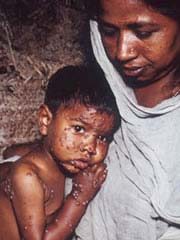
The European Space Agency (ESA) and the Canadian Space Agency (CSA) have announced a call to communication companies who are interested in undertaking a contract for brand communication services related to the International Space Station (ISS).
The contract is a significant move for ESA and CSA who want to heighten the profile of the ISS within Europe and Canada to help meet the commercial objectives of the Space Station.
The two organisations want to hear expressions of interest

New drug could soon thwart smallpox outbreaks
An anti-smallpox pill could be on the way if a new compound that shows promise in animal tests proves safe and effective in humans. Such a pill could provide the best method for controlling an unforeseen smallpox outbreak, its developers claim.
The need for new ways to treat smallpox has only become an issue in recent years as the threat of a deliberate release of the virus intensifies. Smallpox – a highly contagious and often let

Tooth decay could soon be detected without resorting to potentially harmful X-rays – by using a novel electrical technique developed by dental researchers at the University of Dundee in an unusual partnership with textile experts at Heriot Watt University.
Laboratory tests show the device, which measures the electrical resistance of teeth, is twice as accurate as current examination techniques and detects decay in its earliest stages when preventive treatment is still possible.
Know

Grant Supports Young Researchers in Czech Republic, Hungary, Poland Heidelberg, Germany – The European Molecular Biology Organization (EMBO) announces that the Howard Hughes Medical Institute (HHMI) has joined the organization in supporting young scientists from Central Europe, namely the Czech Republic, Hungary and Poland. The HHMI provides $ 2 Mio for the next four years to the EMBO Young Investigator Programme. Each year six scientists can be supported with Euro 30 000 per year for a durat

In a joint project between the Technology Foundation STW and the energy agency Novem at Utrecht University, researchers have developed new silicon layers which are more stable and cheaper than the present amorphous silicon layers. The electronic properties of the present layers in laptop screens and solar cells deteriorate if the material is under ‘stress’, for example due to sunshine or a voltage.
Flat-panel displays and solar cells have a substrate of glass or plastic, which is coated with

Satellite images have revealed the collapse of Larsen B ice shelf on the Antarctic Peninsula fulfilling predictions made by British Antarctic Survey (BAS) scientists. The collapse of the 3250 km2 ice shelf is the latest drama in a region of Antarctica that has experienced unprecedented warming over the last 50 years.
Earlier this month Ted Scambos of the University of Colorado alerted BAS glaciologists David Vaughan and Chris Doake to images from the NASA MODIS satellite. Meanwhile, in Antar

– new calculation confirms standard model of particle physics. Contribution of hadronic vacuum polarization determined with unprecedented accuracy. The magnetic moment of the muon is an important precision parameter for…
Technique may prevent formation of unwanted waves that siphon off needed energy. Heating plasma to the ultra-high temperatures needed for fusion reactions requires more than turning the dial on a…

An international team of astronomers, led by researchers from the Astronomical Observatory of the University of Warsaw, have identified a new class of cosmic X-ray sources. The findings have been…

How deubiquitinases USP53 and USP54 cleave long polyubiquitin chains and how the former is linked to liver disease in children. Deubiquitinases (DUBs) are enzymes used by cells to trim protein…

Conceptual blueprint to analyze experimental catalyst data. Machine learning (ML) models have recently become popular in the field of heterogeneous catalyst design. The inherent complexity of the interactions between catalyst…

Antibody that Neutralizes Inhibitory Factors Involved in Nerve Regeneration Leads to Enhanced Motor Function after Acute Spinal Cord Injury. Researchers at 13 clinics in Germany, Switzerland, the Czech Republic and…

How simulations help manufacturing of modern displays. Modern materials must be recyclable and sustainable. Consumer electronics is no exception, with organic light-emitting diodes (OLEDs) taking over modern televisions and portable…

“Neurons that fire together, wire together” describes the neural plasticity seen in human brains, but neurons grown in a dish don’t seem to follow these rules. Neurons that are cultured…

The quest for sustainable energy solutions has been a major focus of scientific research for decades. Solar energy, a clean and renewable source, has emerged as a promising alternative to…

With a processing speed a billion times faster than nature, chip-based laser neuron could help advance AI tasks such as pattern recognition and sequence prediction. Researchers have developed a laser-based…

New technology could remotely identify various types of plastics, offering a valuable tool for future monitoring and analysis of oceanic plastic pollution. Researchers have developed a new hyperspectral Raman imaging…

Artificial Intelligence (AI) has established a strong presence across industries, large and small. The “VoBaKI” research project has empowered small and medium-sized enterprises (SMEs) with an innovative tool to independently…